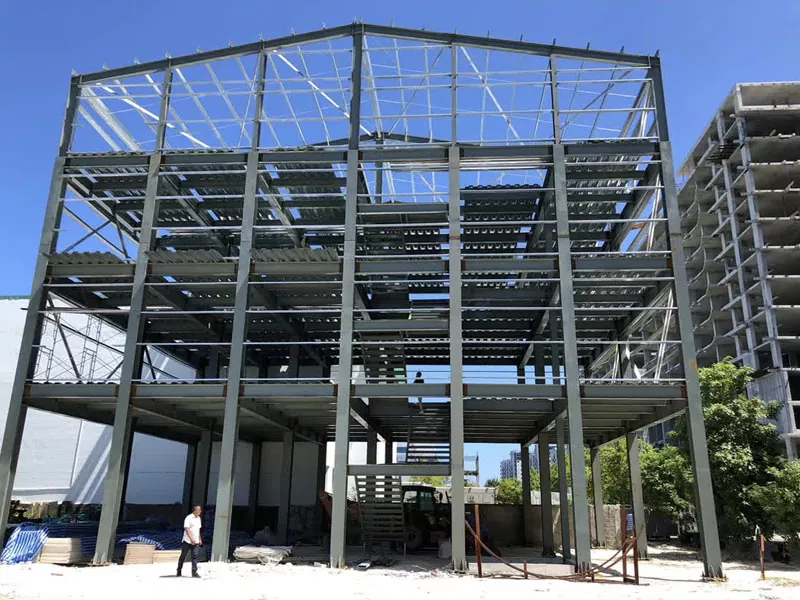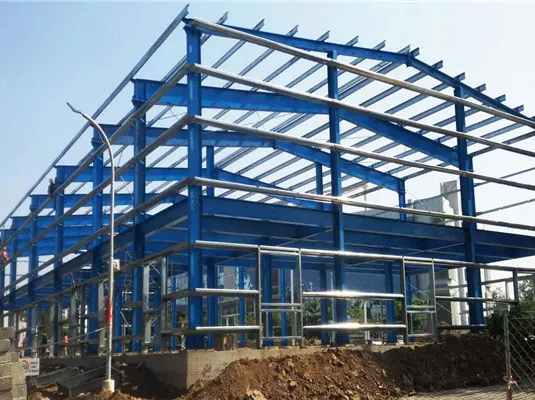QR Code

1. High Strength and Durability Steel frame warehouses are renowned for their high strength and durability. Steel's inherent properties allow these structures to withstand large loads and harsh weather conditions, including earthquakes and hurricanes. The robustness of steel ensures the warehouse maintains its structural integrity, providing a safe environment for stored goods.
2. Lightweight and Flexible Design One of the significant advantages of steel frame warehouses is their lightweight nature compared to traditional concrete structures. This characteristic reduces the load on the foundation, allowing for more flexibility in design and adaptability to various terrains. The lightweight nature also contributes to lower construction costs and easier transportation and installation of prefabricated components.
3. Faster Construction Time The prefabrication process involves manufacturing steel components in a controlled factory setting, which are then transported to the construction site for assembly. This method significantly reduces construction time as most components are pre-made and only require assembly on-site. Faster construction translates into quicker occupancy, providing businesses with a faster return on investment.
4. Cost-Effectiveness Steel frame warehouses are cost-effective due to lower production costs and efficient material usage during the prefabrication process. The reduced construction time also lowers labor costs and project overheads. Additionally, the long lifespan and low maintenance requirements of steel structures contribute to cost savings over the building's lifecycle.
5. Environmental Sustainability Steel is a recyclable material, making steel frame warehouses an environmentally friendly choice. The efficiency of the prefabrication process minimizes waste, and the durability of steel reduces the need for frequent repairs and replacements. These factors contribute to a lower environmental impact compared to traditional construction methods.
1. Planning and Design The initial stage of constructing a steel frame warehouse involves detailed planning and design. This includes determining the warehouse's size, capacity, layout, and any specialized features required. A comprehensive design plan is created, outlining the dimensions, materials, and construction methods to be used.
2. Foundation Preparation Geological surveys are conducted to assess the soil conditions and determine the appropriate foundation type, such as concrete slabs or piles. The foundation is prepared according to design specifications to support the weight and loads of the steel structure.
3. Steel Structure Fabrication Steel components, including beams, columns, braces, and roof trusses, are prefabricated in a factory using high-quality steel. Precision engineering ensures these components fit together accurately and securely during installation.
4. Steel Structure Installation The prefabricated steel components are transported to the construction site and assembled using cranes and other heavy equipment. The installation process begins with erecting and anchoring the columns to the foundation, followed by installing beams to form the warehouse frame. Roof trusses are then secured to support the roofing system.
5. Roofing and Exterior Cladding Once the steel frame is complete, the roofing system is installed, typically using insulated metal panels or single-ply membrane materials. Exterior walls, if included in the design, are also installed using metal panels, brick, or other cladding materials.
6. Interior Finishes and Systems The interior of the warehouse is finished according to specified requirements, including flooring, lighting, ventilation, and fire protection systems. Storage racks, mezzanines, and other specialized equipment may be installed to optimize the warehouse's operational efficiency.
7. Inspection and Testing Upon completion, the warehouse undergoes thorough inspection and testing to ensure it meets all safety and quality standards. Load testing may be performed to verify the structure's ability to support the intended loads.
8. Commissioning and Handover Once the warehouse is deemed safe and ready for use, it is commissioned and handed over to the owner or operator. Final documentation, including as-built drawings, warranties, and operating manuals, is provided to facilitate ongoing maintenance and operation.
1. Corrosion Resistance Steel is susceptible to corrosion, which can compromise the structural integrity of the warehouse. To mitigate this, protective coatings and galvanization are applied to steel components. Regular maintenance and inspections are also essential to address any signs of corrosion promptly.
2. Fire Resistance While steel is non-combustible, it can lose strength at high temperatures. Fireproofing measures, such as applying fire-resistant coatings and incorporating fire-resistant materials in construction, enhance the fire resistance of steel frame warehouses.
3. Noise and Thermal Conductivity Steel structures can conduct noise and heat, potentially affecting the warehouse's internal environment. Insulation materials and soundproofing techniques are used to address these issues, ensuring a comfortable and efficient workspace.
4. Complex Foundation Requirements Steel frame warehouses may require specialized foundations, especially in areas with poor soil conditions. Conducting thorough geological surveys and designing appropriate foundations are crucial to ensuring the stability and safety of the warehouse.
5. Environmental Impact While steel is recyclable, the production process can have a significant environmental impact. Sustainable practices, such as using recycled steel and implementing energy-efficient manufacturing processes, help reduce the environmental footprint of steel frame warehouses.
Numerous examples of prefabricated steel frame warehouses around the world demonstrate the practicality and beauty of this construction method. These warehouses vary in size, design, and complexity but share the common feature of using prefabricated steel components for efficient and cost-effective construction. Some notable examples include:
1. Amazon Fulfillment Centers Amazon has utilized steel frame warehouses for its fulfillment centers, enabling rapid construction and expansion of its logistics network. These warehouses are designed to handle large volumes of goods efficiently, with features such as automated storage and retrieval systems.
2. Walmart Distribution Centers Walmart's distribution centers also employ steel frame construction, providing durable and spacious facilities to support its extensive supply chain operations. The flexibility of steel frame design allows Walmart to customize its warehouses to meet specific logistical requirements.
3. Industrial Parks Many industrial parks around the world feature steel frame warehouses due to their adaptability and cost-effectiveness. These warehouses provide versatile spaces for various industries, including manufacturing, storage, and distribution.
The future of practical and beautiful steel frame warehouse construction looks promising, with ongoing innovations and advancements in technology. Some emerging trends include:
1. Smart Warehouses Integrating smart technologies, such as IoT devices and automated systems, enhances the efficiency and functionality of steel frame warehouses. These technologies enable real-time monitoring, inventory management, and predictive maintenance, improving overall operational performance.
2. Sustainable Construction Practices As environmental concerns grow, there is an increasing focus on sustainable construction practices. Using eco-friendly materials, implementing energy-efficient designs, and minimizing waste are becoming standard practices in steel frame warehouse construction.
3. Modular Construction Modular construction techniques, where entire sections of the warehouse are prefabricated and assembled on-site, offer even faster construction times and greater flexibility. This approach allows for easy expansion and modification of warehouse facilities.
4. Advanced Materials Research and development in advanced materials, such as high-strength steel alloys and composite materials, continue to enhance the performance and durability of steel frame warehouses. These materials offer improved resistance to corrosion, fire, and environmental stresses.
Practical and beautiful steel frame warehouse constructionoffers a practical and beautiful solution for the logistics industry. With its high strength, durability, flexibility, and cost-effectiveness, steel frame warehouses meet the demands of modern logistics operations. The prefabrication process ensures faster construction times, reducing costs and providing businesses with a quicker return on investment. Despite challenges such as corrosion and fire resistance, innovative solutions and ongoing advancements in technology continue to improve the performance and sustainability of steel frame warehouses. As the logistics industry evolves, steel frame warehouses will play an increasingly vital role in supporting efficient and effective supply chain operations.


Address
No. 568, Yanqing First Class Road, Jimo High-tech Zone, Qingdao City, Shandong Province, China
Tel

Copyright © 2024 Qingdao Eihe Steel Structure Group Co., Ltd. All Rights Reserved.
Links | Sitemap | RSS | XML | Privacy Policy |
TradeManager
Skype
VKontakte
